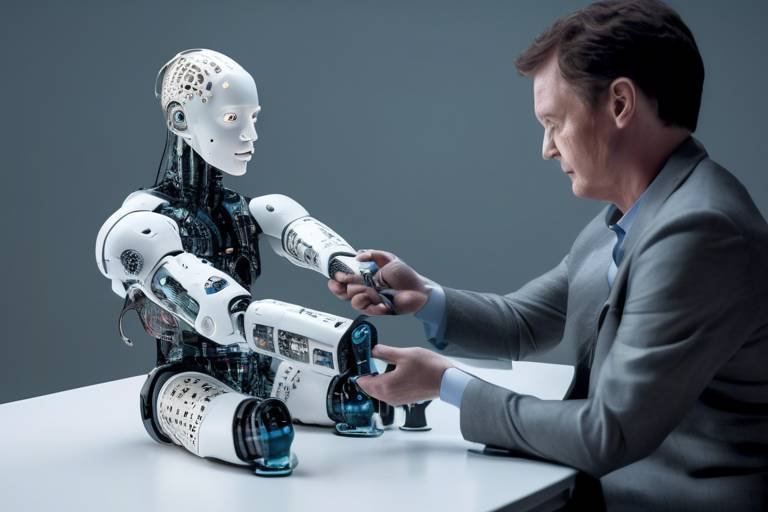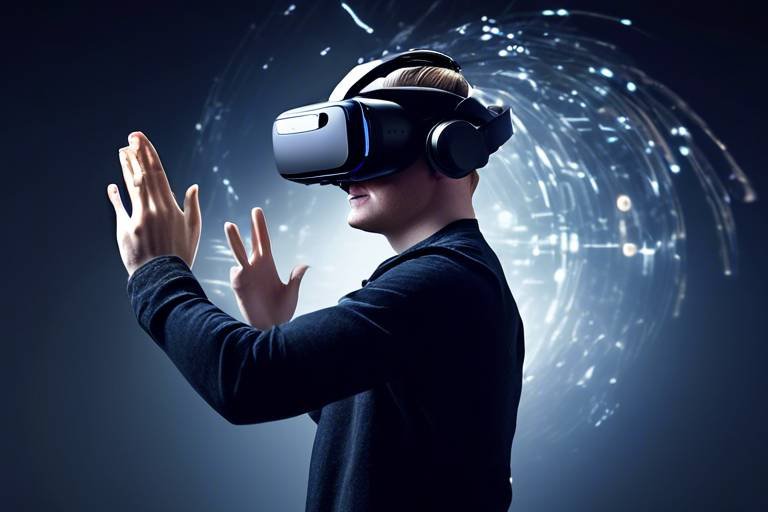The Future of Prosthetics: AI and Robotics
Imagine waking up one morning, slipping on a prosthetic limb that feels like an extension of your own body. It moves with you, responds to your thoughts, and adapts to your environment. This is not a scene from a sci-fi movie; it's the reality that advancements in artificial intelligence (AI) and robotics are making possible in the world of prosthetics. This article delves into how these groundbreaking technologies are reshaping mobility, functionality, and the overall quality of life for users around the globe.
Prosthetic devices have come a long way from the rudimentary wooden legs and hooks of the past. Today, they are equipped with sophisticated sensors, adaptive algorithms, and biomechanical interfaces that enable them to mimic the natural movements of human limbs. These innovations not only enhance the user's physical capabilities but also provide a sense of normalcy and independence that many thought was lost forever.
One of the most exciting aspects of this evolution is the integration of AI technology into prosthetics. AI is revolutionizing the way these devices operate by enabling them to learn from user interactions and adapt to various situations. Imagine a prosthetic arm that can adjust its grip based on the weight and shape of an object you are holding. This level of responsiveness makes daily tasks like eating, typing, or playing sports not just possible, but enjoyable.
In addition to improving functionality, these advanced prosthetics are designed with the user's experience in mind. The goal is not just to restore lost functionality but to enhance it. With features like real-time feedback systems and smart sensors, users can receive immediate information about their movements, allowing them to make adjustments that lead to a more comfortable and intuitive experience. This combination of technology and user-centered design is paving the way for a future where prosthetics are as natural as the limbs they replace.
AI is revolutionizing prosthetics by enabling smarter, more adaptive devices that respond to user intentions and environmental changes, enhancing the overall functionality and usability of prosthetic limbs. This section explores how AI is transforming the landscape of prosthetics, making them more intuitive and responsive.
Robotic prosthetics are designed to mimic natural limb movements, providing users with improved dexterity and control, making daily tasks easier and more intuitive to perform. They utilize advanced robotics to replicate the fluidity of human motion, allowing users to engage in activities they once thought impossible.
Integrating smart sensors into prosthetics allows for real-time feedback, enabling users to adjust their movements and grip strength, leading to a more natural and comfortable experience. This technology ensures that users can interact with their environment seamlessly, whether they're holding a delicate object or performing heavy lifting tasks.
Biomechanical interfaces connect the user's nervous system to the prosthetic limb, facilitating direct control and enhancing the user's ability to perform complex tasks with precision. This connection creates a direct line of communication between the brain and the prosthetic, allowing for movements that feel instinctual rather than mechanical.
Adaptive algorithms analyze user movements and preferences, allowing prosthetics to learn and adapt over time, ultimately improving performance and user satisfaction. This means that the more you use your prosthetic, the better it becomes at understanding your unique style and preferences, making it feel more like a part of you.
Telemedicine is becoming increasingly important in prosthetic care, allowing healthcare professionals to monitor patient progress and adjust devices remotely, ensuring optimal performance and user support. This innovation not only saves time but also enhances the overall care experience for users.
Despite advancements, challenges remain in the development of prosthetics, including cost, accessibility, and the need for ongoing research to address user-specific needs and preferences. Understanding these challenges is crucial for creating a future where prosthetics are available to everyone who needs them.
The high cost of advanced prosthetics often limits access for many individuals, highlighting the need for more affordable solutions and insurance coverage to ensure equitable access to these technologies. Without addressing these financial barriers, many people may be left behind in this technological revolution.
Customizing prosthetics to meet individual user needs is crucial for enhancing comfort and functionality, requiring ongoing collaboration between engineers, healthcare providers, and users. This collaborative approach ensures that prosthetics are tailored to the unique lifestyles and preferences of each user, ultimately leading to a better quality of life.
- What are the main benefits of AI in prosthetics?
AI enhances the adaptability and functionality of prosthetics, allowing them to respond to user intentions and environmental changes, ultimately improving the user experience.
- How do robotic prosthetics mimic natural movement?
Robotic prosthetics utilize advanced robotics and sensors to replicate the fluidity of human motion, providing improved dexterity and control for the user.
- What challenges do users face with prosthetics?
Challenges include high costs, accessibility issues, and the need for customization to meet individual user needs.

Advancements in AI Technology
In recent years, the realm of prosthetics has witnessed a seismic shift, largely thanks to the integration of artificial intelligence (AI). Imagine a prosthetic limb that not only responds to your movements but also learns from them—this is the promise of AI-driven technology. These advanced devices are no longer just static tools; they are becoming intelligent companions that adapt to the user's needs and environment. This transformation is akin to upgrading from a simple, manual typewriter to a sophisticated word processor that anticipates your needs and improves your writing experience.
One of the most exciting aspects of AI in prosthetics is its ability to enhance mobility and functionality. By utilizing machine learning algorithms, these prosthetics can analyze user behavior and preferences, allowing them to adjust their performance in real-time. For instance, if a user tends to grip objects with varying strength, the prosthetic can learn this pattern and automatically adjust its grip, making daily tasks feel more natural and intuitive. This is like having a personal assistant who knows exactly how you like your coffee—no more guesswork!
Furthermore, the incorporation of smart sensors into prosthetic devices has revolutionized user interaction. These sensors provide real-time feedback, allowing users to gauge their movements and make adjustments on the fly. Imagine trying to catch a ball; with a traditional prosthetic, this task could feel clumsy and awkward. However, with smart sensors, the prosthetic can detect the speed and angle of the ball, enabling the user to respond more effectively. This level of responsiveness not only enhances the user experience but also significantly boosts confidence in performing complex tasks.
Another groundbreaking advancement is the development of biomechanical interfaces. These interfaces create a direct connection between the user’s nervous system and the prosthetic limb, essentially translating neural signals into movement. This is a game-changer for users, as it allows for a level of control that was previously thought impossible. Picture this: instead of merely pushing a button to activate a prosthetic, users can now think about moving their limb, and the prosthetic responds accordingly. It’s like having a direct line of communication between your brain and your artificial limb!
Moreover, the future of prosthetics is also being shaped by adaptive algorithms. These algorithms are designed to learn from user interactions over time, continuously improving the performance of the prosthetic. For example, if a user frequently engages in specific activities, the algorithm can optimize the prosthetic's settings to enhance performance in those areas. This adaptability not only makes the prosthetic more efficient but also significantly increases user satisfaction. It’s like having a car that learns your driving habits and adjusts its settings for a smoother ride!
In summary, the advancements in AI technology are transforming the landscape of prosthetics, making them more responsive, intuitive, and user-friendly. As these technologies continue to evolve, we can expect to see even more remarkable innovations that will enhance the quality of life for users, providing them with a level of independence and functionality that was once unimaginable.

Robotic Innovations in Prosthetics
When we think about the future of prosthetics, it's hard not to be amazed by the incredible robotic innovations that are reshaping the landscape of mobility and functionality. Imagine a world where artificial limbs not only replace lost functionality but also enhance the user's ability to perform everyday tasks with ease and precision. That's the reality we are stepping into! Robotic prosthetics are designed to mimic natural limb movements, which is a game-changer for individuals who rely on them. These devices don't just sit there; they actively engage with the user, providing a sense of autonomy that many thought was lost forever.
One of the most exciting aspects of robotic prosthetics is their ability to offer improved dexterity and control. These devices are equipped with advanced robotics that allow for a range of motions that closely resemble the movements of a natural limb. For instance, consider how a simple task like picking up a cup can be transformed. With traditional prosthetics, this might require a series of awkward maneuvers, but with robotic innovations, users can effortlessly grasp, lift, and even pour with a newfound level of finesse. This is not just about making life easier; it's about empowering individuals to engage in activities they love.
To illustrate the impact of these innovations, let's take a closer look at some of the key features that make robotic prosthetics stand out:
- Advanced Actuation Systems: These systems allow for smooth and natural movements, mimicking the biomechanics of real limbs.
- Adaptive Control: Robotic limbs can adjust their grip and movement based on the task at hand, whether it's holding a delicate object or lifting something heavy.
- Intuitive Interfaces: Users can control their prosthetics through simple muscle contractions or even brain signals, making the experience feel more organic.
Moreover, the integration of smart technology has further enhanced these devices. Imagine a prosthetic arm that learns from your movements and adapts over time! This is not science fiction; it’s happening now. Robotic prosthetics equipped with machine learning algorithms can analyze how a user interacts with their environment and adjust their performance accordingly. This means that over time, the prosthetic becomes more attuned to the user's unique style, making every movement feel more natural and less mechanical.
Another fascinating aspect of these innovations is the incorporation of telemetry and feedback systems. With these systems, users receive real-time feedback on their movements, allowing them to fine-tune their actions for maximum efficiency. This is akin to having a personal coach in your pocket, guiding you through the nuances of using your new limb. The ability to receive immediate feedback not only enhances skill development but also boosts confidence, making users feel more in control of their lives.
In conclusion, the realm of robotic innovations in prosthetics is not just about replacing lost limbs; it's about revolutionizing the way individuals interact with the world around them. These advancements are paving the way for a future where mobility is not a limitation but a newfound freedom. As we continue to push the boundaries of technology, one can only imagine the incredible possibilities that lie ahead in the field of prosthetics.
Q: How do robotic prosthetics work?
A: Robotic prosthetics utilize advanced sensors and actuators to mimic natural limb movements, allowing users to control them through muscle contractions or brain signals.
Q: Are robotic prosthetics customizable?
A: Yes, many robotic prosthetics can be customized to fit the individual needs and preferences of the user, enhancing comfort and functionality.
Q: What is the cost of robotic prosthetics?
A: The cost can vary widely depending on the technology and features included, but advanced robotic prosthetics often come with a high price tag, making accessibility a challenge for some users.
Q: Can robotic prosthetics be monitored remotely?
A: Yes, many modern prosthetics come equipped with telemedicine capabilities, allowing healthcare providers to monitor user performance and make adjustments as needed.

Smart Sensors and Feedback Systems
The integration of smart sensors into prosthetic devices is nothing short of revolutionary. Imagine a world where your prosthetic limb not only responds to your movements but also understands your intentions and surroundings. This is the promise of smart sensors, which are designed to provide real-time feedback, making the experience of using a prosthetic limb feel more natural and intuitive.
These sensors monitor various parameters such as pressure, temperature, and motion, allowing for a dynamic interaction between the user and the prosthetic. For instance, when a user picks up a delicate object, the smart sensors can detect the required grip strength and adjust accordingly, preventing damage to the item. This capability significantly enhances the user's confidence and independence, making everyday tasks less daunting.
Furthermore, the feedback systems incorporated into these devices enable users to receive immediate sensory information about their environment. This means that a user can feel the difference between holding a soft fabric and a hard surface, which is crucial for performing tasks that require a delicate touch. The ability to feel is a game-changer, as it bridges the gap between artificial and natural limbs.
To illustrate the impact of these systems, consider the following table that showcases the key advantages of smart sensors in prosthetics:
| Feature | Benefit |
|---|---|
| Real-time Feedback | Allows users to adjust grip and movement instantly, leading to more natural interactions. |
| Pressure Sensitivity | Helps prevent damage to delicate items by regulating grip strength. |
| Environmental Awareness | Enables users to feel different textures and temperatures, enhancing control. |
As we look to the future, the potential for these smart sensors to evolve is immense. With advancements in machine learning and artificial intelligence, we can expect prosthetics equipped with sensors that not only learn from the user’s movements but also predict their needs. This means that your prosthetic could potentially anticipate your actions, making the experience even more seamless and integrated into your daily life.
In summary, smart sensors and feedback systems are transforming the landscape of prosthetic technology. They not only improve functionality but also enhance the overall quality of life for users by providing a sense of connection and control that was previously unimaginable. As these technologies continue to develop, we can only anticipate a future where prosthetics become an extension of the human body, rather than just a substitute.
- What are smart sensors in prosthetics? Smart sensors are advanced devices that provide real-time feedback to users, allowing for more intuitive control and interaction with prosthetic limbs.
- How do feedback systems improve the use of prosthetics? Feedback systems enable users to adjust their movements and grip strength based on sensory information, making the experience more natural and user-friendly.
- Can smart sensors help with delicate tasks? Yes, they can adjust grip strength and provide tactile feedback, allowing users to perform delicate tasks without damaging objects.

Biomechanical Interfaces
Biomechanical interfaces are a groundbreaking innovation in the realm of prosthetics, acting as a bridge between the user's nervous system and the prosthetic limb. Imagine being able to control a robotic arm just by thinking about it! This technology transforms the way users interact with their prosthetics, making the experience much more intuitive and natural. By harnessing the power of neurotechnology, these interfaces enable direct communication between the brain and the device, allowing for precise movements and actions that closely mimic those of a biological limb.
At the heart of biomechanical interfaces is the use of electromyography (EMG), which captures electrical signals generated by muscle contractions. When a user thinks about moving their prosthetic limb, these signals are detected and translated into commands that the prosthetic can understand. This process is akin to using a remote control to operate a toy car, where the user's thoughts and intentions drive the movement of the device. The result? A prosthetic limb that feels less like a foreign object and more like an extension of the body.
Moreover, the integration of advanced sensors and algorithms allows these interfaces to adapt to the user's movements over time. For instance, if a user frequently performs a specific action, such as grasping objects, the system can learn and optimize the grip strength and motion required for that task. This adaptability not only enhances the functionality of the prosthetic but also significantly improves the user's overall experience. In essence, biomechanical interfaces are not just about restoring lost functionality; they are about enhancing the quality of life by empowering users to engage in activities with confidence and ease.
However, the development of biomechanical interfaces is not without its challenges. The technology requires extensive research and testing to ensure safety and reliability. Additionally, the complexity of the human nervous system means that customization is often necessary to accommodate individual user needs. This customization process involves close collaboration among engineers, healthcare providers, and users to create a device that truly fits the user's lifestyle and preferences.
In summary, biomechanical interfaces represent a significant leap forward in prosthetic technology. By creating a seamless connection between the user and the device, they offer a glimpse into the future of prosthetics—where technology and biology work hand in hand to enhance mobility and independence. As research continues to evolve, we can expect even more sophisticated interfaces that will push the boundaries of what is possible in the world of prosthetics.
- What are biomechanical interfaces?
Biomechanical interfaces connect the user's nervous system to a prosthetic limb, allowing for direct control and more natural movements. - How do these interfaces work?
They use signals from muscle contractions, captured through electromyography (EMG), to translate thoughts into actions for the prosthetic device. - What are the benefits of using biomechanical interfaces?
They enhance the functionality of prosthetics, making them more intuitive and responsive to the user's needs, ultimately improving quality of life. - Are there challenges in developing biomechanical interfaces?
Yes, challenges include ensuring safety, reliability, and the need for customization to meet individual user requirements.

Adaptive Algorithms
Adaptive algorithms represent a groundbreaking leap in the realm of prosthetics, transforming the way users interact with their artificial limbs. These algorithms function like a personal trainer for prosthetics, constantly learning and adjusting to the user's movements and preferences. Imagine having a prosthetic limb that not only understands your intentions but also evolves with you over time—this is the promise of adaptive algorithms.
By analyzing data from various sensors embedded in the prosthetic, these algorithms can detect patterns in the user’s movements. For example, if a user often adjusts their grip when holding a cup, the algorithm recognizes this behavior and fine-tunes the grip strength accordingly. This level of personalization is akin to having a device that knows you better than you know yourself, making daily tasks feel more intuitive and less cumbersome.
Moreover, adaptive algorithms enhance the overall user experience by providing feedback mechanisms that encourage users to engage with their prosthetics more actively. Consider this: when you learn to ride a bike, you adjust your balance and pedaling based on how the bike responds. Similarly, these algorithms provide real-time adjustments, allowing users to refine their movements based on immediate feedback. This feedback loop not only improves functionality but also boosts the user's confidence in using their prosthetic.
However, the implementation of adaptive algorithms is not without challenges. The complexity of programming these algorithms requires a multidisciplinary approach, involving experts in robotics, AI, and human physiology. To ensure the algorithms are effective, continuous data collection and analysis are essential. This means that the prosthetic must be equipped with advanced sensors that can relay information back to the algorithm in real-time. The integration of such technology can be costly, but the benefits far outweigh the initial investment.
In summary, adaptive algorithms are revolutionizing prosthetic technology by creating devices that are not only responsive but also personalized. They offer a glimpse into a future where artificial limbs can seamlessly integrate into a user's life, enhancing mobility and independence. As research continues and technology advances, we can expect these algorithms to become even more sophisticated, paving the way for a new era in prosthetic design.
- What are adaptive algorithms in prosthetics?
Adaptive algorithms are advanced software programs that allow prosthetic devices to learn from the user's movements and preferences, enabling them to adjust and improve functionality over time. - How do adaptive algorithms enhance user experience?
These algorithms provide real-time feedback and adjustments, making the prosthetic feel more intuitive and natural to use, thus boosting the user's confidence and independence. - What challenges are associated with implementing adaptive algorithms?
The main challenges include the complexity of programming, the need for advanced sensors, and the cost of developing such sophisticated technology.

Telemedicine and Remote Monitoring
Telemedicine is rapidly transforming the landscape of prosthetic care, offering a lifeline for users who require consistent support and adjustments to their devices. Imagine being able to consult with a healthcare professional without the hassle of scheduling an in-person visit. With the integration of advanced technologies, this is becoming a reality. Remote monitoring allows healthcare providers to track a patient's progress in real-time, making it easier to identify issues and implement solutions promptly. This innovative approach not only saves time but also enhances the overall quality of care.
Consider this: a patient with a newly fitted prosthetic limb can send data about their usage patterns directly to their healthcare provider. This data can include information about how often they are using the prosthetic, any discomfort they may be experiencing, and even the types of activities they are engaging in. Through this continuous flow of information, healthcare professionals can make informed decisions about necessary adjustments, such as recalibrating the device or suggesting exercises to improve the user’s comfort and functionality.
Moreover, telemedicine facilitates a more personalized approach to prosthetic care. Patients no longer need to wait weeks for a follow-up appointment; instead, they can have virtual consultations where they can discuss their experiences and receive immediate feedback. This immediacy not only fosters a stronger patient-provider relationship but also empowers users to take an active role in their rehabilitation journey.
The benefits of telemedicine in prosthetic care extend beyond just convenience. It significantly reduces the burden on healthcare systems by minimizing unnecessary visits, allowing professionals to allocate their time and resources more efficiently. In rural or underserved areas, where access to specialized care might be limited, telemedicine serves as a bridge, connecting patients with experts who can provide guidance and support from afar.
In summary, the integration of telemedicine and remote monitoring in prosthetic care is a game-changer. By harnessing technology, we can ensure that users receive timely support, which translates into better outcomes and enhanced quality of life. As these systems continue to evolve, we can expect even more innovative solutions that will redefine what it means to live with a prosthetic limb.
- What is telemedicine in prosthetic care?
Telemedicine in prosthetic care refers to the use of technology to provide remote consultations and monitoring for patients using prosthetic devices, allowing for real-time adjustments and support. - How does remote monitoring benefit prosthetic users?
Remote monitoring allows healthcare professionals to track the usage and performance of prosthetic devices, enabling timely interventions and personalized care without the need for in-person visits. - Can telemedicine improve the relationship between patients and healthcare providers?
Yes, telemedicine fosters a more open line of communication, allowing for regular check-ins and feedback, which strengthens the patient-provider relationship and enhances trust. - Are there any limitations to telemedicine in prosthetic care?
While telemedicine offers many benefits, limitations can include technological barriers for some patients, as well as the need for certain assessments to be conducted in person.

Challenges in Prosthetic Development
Despite the remarkable advancements in prosthetic technology, the journey is not without its hurdles. One of the most pressing challenges is the high cost associated with advanced prosthetic devices. These state-of-the-art solutions, often equipped with cutting-edge AI and robotics, can be prohibitively expensive, making them inaccessible to many individuals who could benefit from them. Imagine a world where someone has to choose between basic necessities and a limb that could significantly improve their quality of life—it's a dilemma that far too many face today.
Moreover, the issue of accessibility cannot be overlooked. In many regions, especially in developing countries, the availability of advanced prosthetic technology is limited. This disparity raises ethical concerns about equity in healthcare. Why should someone’s ability to move freely and live fully depend on where they were born? The answer is clear: we need to advocate for more affordable solutions and better insurance coverage that can ensure equitable access to these life-changing technologies.
Customization also poses a significant challenge in prosthetic development. Each user has unique needs and preferences, and a one-size-fits-all approach simply doesn't cut it. To enhance comfort and functionality, prosthetics must be tailored to the individual. This process requires ongoing collaboration among engineers, healthcare providers, and users. It’s a bit like crafting a bespoke suit; it takes time, effort, and a keen understanding of the wearer’s needs. The goal is to create a prosthetic that feels like a natural extension of the body rather than a foreign object.
In addition to these challenges, there is a critical need for ongoing research to address user-specific needs. The field of prosthetics is evolving rapidly, but to keep pace with these changes, continuous innovation is essential. Researchers and developers must work together to explore new materials, designs, and technologies that can enhance user experience. This collaborative effort can lead to breakthroughs that not only improve the functionality of prosthetics but also make them more affordable and accessible.
To summarize, the challenges in prosthetic development are multifaceted and require a concerted effort from various stakeholders. Addressing the issues of cost, accessibility, customization, and research will be vital in shaping the future of prosthetics. As we move forward, it is essential to keep the conversation alive and advocate for solutions that prioritize the needs of users. After all, every individual deserves the right to mobility and independence.
- What are the main challenges in prosthetic development? The main challenges include high costs, limited accessibility, the need for customization, and ongoing research to meet user-specific needs.
- Why is customization important in prosthetics? Customization enhances comfort and functionality, allowing the prosthetic to feel like a natural extension of the body.
- How can we improve access to advanced prosthetics? Advocating for more affordable solutions and better insurance coverage is crucial for ensuring equitable access to these technologies.
- What role does research play in prosthetic development? Ongoing research is essential for exploring new materials, designs, and technologies that can enhance user experience and improve the functionality of prosthetics.

Cost and Accessibility Issues
The journey towards improved prosthetic technology is not without its hurdles. One of the most significant challenges is the cost associated with advanced prosthetics. While innovations in AI and robotics have led to remarkable enhancements in functionality, these cutting-edge devices often come with a hefty price tag. For many individuals, the financial burden can be overwhelming, limiting their access to the life-changing benefits that modern prosthetics offer. In fact, the average cost of a prosthetic limb can range from $5,000 to over $100,000, depending on the technology and customization required. This disparity often leaves those in need of prosthetics at a disadvantage, particularly in regions where healthcare coverage is minimal or non-existent.
Accessibility goes hand in hand with cost. Even when advanced prosthetics are available, the lack of insurance coverage or insufficient reimbursement policies can make it nearly impossible for many individuals to obtain the devices they need. This situation not only affects the physical mobility of users but can also have profound implications for their mental health and overall quality of life. Imagine being unable to participate in everyday activities simply because the tools required to do so are out of reach. It’s a harsh reality for many, and it highlights the urgent need for systemic changes in healthcare policy.
To address these challenges, there are several potential solutions that could pave the way for greater accessibility:
- Increased Insurance Coverage: Advocating for comprehensive insurance policies that cover advanced prosthetics would significantly alleviate the financial burden on users.
- Research and Development Grants: Government and private sector funding aimed at reducing the cost of prosthetic technologies could lead to more affordable options.
- Community Outreach Programs: Local organizations can play a pivotal role in connecting individuals with resources and financial assistance for obtaining prosthetics.
Ultimately, addressing cost and accessibility issues is crucial for ensuring that the benefits of advanced prosthetic technologies are available to everyone who needs them. By fostering collaboration between stakeholders—engineers, healthcare providers, policymakers, and users—we can work towards a future where high-quality prosthetics are within reach for all.
- What factors contribute to the high cost of prosthetics? The cost is influenced by the technology used, customization needs, and the materials required for manufacturing.
- Are there financial assistance programs available for prosthetic users? Yes, various organizations and charities offer financial aid and support for individuals in need of prosthetics.
- How can I advocate for better insurance coverage for prosthetics? Engaging with local policymakers and raising awareness through community initiatives can help push for necessary changes in insurance policies.

Customization and User Experience
When it comes to prosthetics, one size definitely does not fit all. The journey to finding the perfect prosthetic limb is often filled with challenges, and this is where customization plays a pivotal role. Imagine trying to wear a shoe that’s two sizes too big or too small; it’s uncomfortable and impractical, right? The same principle applies to prosthetics. Customization ensures that each device is tailored to the unique needs of the user, enhancing both comfort and functionality.
To delve deeper, let’s consider the various aspects of customization that can significantly improve user experience:
- Physical Fit: Every individual's anatomy is different, and a well-fitted prosthetic can make all the difference. Custom molds and measurements ensure that the prosthetic aligns perfectly with the user’s residual limb, minimizing discomfort and maximizing efficiency.
- Functionality: Different users have different lifestyles and requirements. For instance, an athlete may need a prosthetic that supports high-impact activities, while someone with a more sedentary lifestyle might prioritize comfort and ease of use. Customizing the functionality of the prosthetic allows users to engage in their preferred activities without hindrance.
- Aesthetic Preferences: Let’s not forget the importance of aesthetics! Users often wish to express their personal style through their prosthetics. Customization can include color choices, designs, and even textures that reflect the user’s personality, making the limb not just a tool, but a part of their identity.
Collaboration is key in the customization process. Engineers, healthcare providers, and users must work together to create a prosthetic that meets all the necessary criteria. This collaboration often involves multiple consultations and adjustments, ensuring that the final product is not only functional but also comfortable and visually appealing.
However, the customization process doesn't end once the prosthetic is fitted. Continuous feedback from the user is crucial for ongoing adjustments. For instance, as users become more accustomed to their prosthetics or if their physical condition changes, the prosthetic may need to be altered. This iterative process is essential for ensuring that the prosthetic remains effective and comfortable over time.
In conclusion, the relationship between customization and user experience in prosthetics cannot be overstated. A tailored prosthetic not only enhances physical capabilities but also significantly boosts the user’s confidence and quality of life. By prioritizing the unique needs and preferences of each individual, we can pave the way for a more inclusive and functional future in prosthetic technology.
- What is the importance of customization in prosthetics?
Customization ensures that prosthetics fit well, function according to the user's lifestyle, and reflect personal style, ultimately enhancing comfort and usability. - How can users provide feedback for their prosthetics?
Users can communicate their experiences and needs through regular consultations with their healthcare providers, which helps in making necessary adjustments. - Are there specific technologies used in customizing prosthetics?
Yes, technologies such as 3D printing and digital scanning are often utilized to create precise molds and designs tailored to individual users.
Frequently Asked Questions
- What advancements are being made in prosthetic technology?
Prosthetic technology is experiencing a revolution thanks to advancements in artificial intelligence and robotics. These technologies are enabling the development of smarter, more adaptive devices that can respond to user intentions and environmental changes, significantly enhancing functionality and usability.
- How do robotic prosthetics improve user experience?
Robotic prosthetics are designed to closely mimic the natural movements of limbs. This means users can enjoy improved dexterity and control, making everyday tasks feel more intuitive and less cumbersome. Imagine being able to pick up a delicate item without worrying about dropping it—these innovations are making that a reality!
- What role do smart sensors play in modern prosthetics?
Smart sensors are game-changers in the world of prosthetics. They provide real-time feedback, allowing users to adjust their movements and grip strength on the fly. This leads to a more natural and comfortable experience, almost like the prosthetic limb is a part of the user's own body.
- Can prosthetics be controlled directly by the user's nervous system?
Absolutely! Biomechanical interfaces connect the user's nervous system to the prosthetic limb. This connection allows for direct control, enabling users to perform complex tasks with incredible precision. It's like having a second chance at natural movement!
- What are adaptive algorithms and how do they benefit users?
Adaptive algorithms are smart systems that analyze user movements and preferences. Over time, they allow prosthetics to learn and adapt, improving performance and user satisfaction. Think of it like having a personal trainer for your prosthetic limb, helping it get better at what you need it to do.
- How is telemedicine impacting prosthetic care?
Telemedicine is revolutionizing prosthetic care by allowing healthcare professionals to monitor patient progress remotely. This means adjustments can be made quickly and efficiently, ensuring that users get the best support and performance from their devices without needing to make frequent trips to the clinic.
- What challenges do developers face in creating advanced prosthetics?
Despite the amazing advancements, developers still face challenges like high costs and accessibility issues. Many individuals find it difficult to afford these advanced devices, highlighting the need for more affordable solutions and better insurance coverage to ensure everyone has access to the latest technology.
- Why is customization important in prosthetic development?
Customization is crucial for enhancing comfort and functionality. Each user has unique needs, so ongoing collaboration between engineers, healthcare providers, and users is essential to create prosthetics that truly fit and work for each individual.



















